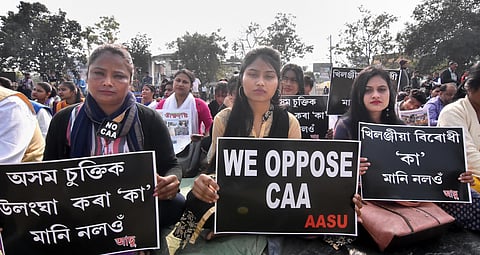

The violent deaths of two non-tribal residents at Ichamati town near the Indo-Bangladesh border in March should serve as a reminder of how sensitive the issue of immigration is in the Northeast. The deaths followed a rally against the Citizenship Amendment Act organised by the Khasi Students Union. The two victims, Ishan Singh and Suji Dutta, were apparently stoned to death not long after the rally concluded. The event should also be a reminder that the concerns here are not always congruent with those in the rest of the country—so one-size-fits-all policies can backfire.
The CAA was pushed strongly in the runup to the 2019 parliamentary election by the ruling BJP and passed by parliament in December that year, only months after the party returned to power with a resounding mandate. On the eve of another election now, the CAA has been notified for promulgation from March 11. Expectedly, the move is being met with celebrations as well as protests in different parts of the country. It must be added that, unlike the last time, there is a sense of resignation among those opposed to the Act and their protest is rather muted.
Judging by its timing, as well as the results of the last Lok Sabha election, this sharp and emotive divide seems calculated to benefit the ruling party in consolidating its vote base. CAA amends the Citizenship Act 1955, to make the route to Indian citizenship faster and easier for Hindu, Sikh, Buddhist, Jain, Parsi and Christian migrants from Afghanistan, Bangladesh and Pakistan, but makes no mention of Muslim migrants. The Act relaxes the 11-year residence requirement under the Citizenship Act to five years for migrants belonging to the specified categories who entered the country before December 31, 2014.
While the celebrations among migrants whose statelessness is promised a quicker and honourable resolution is natural, the objection to it is much more complex. For instance, if the protest against CAA elsewhere in India is largely about a perceived discrimination against Muslims migrants, thereby giving Indian citizenship a colour of religious nationalism, this cannot be said of the Northeast, especially Assam and the states that were once a part of it. Meghalaya is one of them. People here are less discriminate and want all immigrants out, regardless of religion.
The angst over inflow of migrants is endemic in the Northeast. The popular explanation is that ethnic communities here, with the exception of a few, are demographically tiny and vulnerable to being marginalised by an influx of communities far superior in numbers. Few have empathised more with this predicament than Nari Rustomji, a civil servant in the crucial years before and after independence. In his Imperilled Frontiers: India’s North-Eastern Borderlands, while acknowledging the inevitability and universality of the march of development and population movements, he pleads that these changes be regulated to ensure these small communities are able to absorb the changes without detriment to their own social organisms. When this is not so, Rustomji rightly predicted, the consequence will be social friction.
In Assam, this apprehension is most profound and complex. Though not in watertight compartments, the state is today geographically and linguistically divided between the Brahmaputra and Barak valleys. Assamese speakers in the former are generally opposed to the CAA, while Bengali Hindus in the latter welcome it. The six-year ‘anti-foreigner’ agitation that concluded with the signing of the Assam Accord in 1985 was a high point of this friction.
There have been other tragic flashpoints. The Sylhet Referendum on the eve of Indian independence is one. When the Radcliffe Line was being drawn to decide the contours of East Pakistan in this sector, the Hindus in Sylhet hoped to belong to India and be a part of Assam. However, the Assamese leadership at the time, nurturing the hurt of Bengali dominance during British days, refused this as with Sylhet, Assam would become a Bengali majority state.
The history of colonial Assam, which then was almost the entire Northeast, should provide some answers. Assam was annexed by the British and merged with Bengal after the Treaty of Yandaboo in 1826. Assam then was backward and largely unfamiliar with British administration; therefore the latter brought in educated middle class Hindu Bengalis well acquainted with the British system, largely from Sylhet, to run their bureaucracy.
This Bengali middle class came to dominate affairs and treated the Assamese with a measure of condescension. In 1837, they influenced the British to make Bengali the official language of Assam, arguing that Assamese was a dialect of Bengali. The nascent Assamese middle class did little, but the seeds for future conflicts were sown. As the Assamese middle class strengthened, resistance grew. In 1873, they caused Assamese to be restored as the official language in five districts in the Brahmaputra valley. The following year, Assam was separated from Bengal to become a chief commissioner’s province.
There were also Bengali Muslim peasants flooding into Assam, but this peasantry came with no baggage of superiority and initially had no trouble integrating, identifying themselves as Assamese speakers. But this was destined to change. As the Indian freedom struggle intensified and acquired the face of a rivalry of religious nationalism between Muslims and Hindus, it manifested as a unique triangular fight in Assam—a clash of linguistic nationalism between Assamese and Bengali speakers, and of religious nationalism between Hindus and Muslims. The undercurrents of the former rivalry remain strong even today.
This long history of rivalry between ethnic sub-nationalities cannot be easily dismissed as being anachronistic. A deeper reconciliation would have to begin from an understanding of a citizenship free of nationalistic colours, with a premium on consensual and need-based rights—first on the broader canvas of the nation, and then the regions as well. Failing this, the potential for periodic friction, such as the one promising to explode again in the wake of the CAA, will continue to fester.
(Views are personal)
(phanjoubam@gmail.com)
Pradip Phanjoubam | Editor, Imphal Review of Arts and Politics